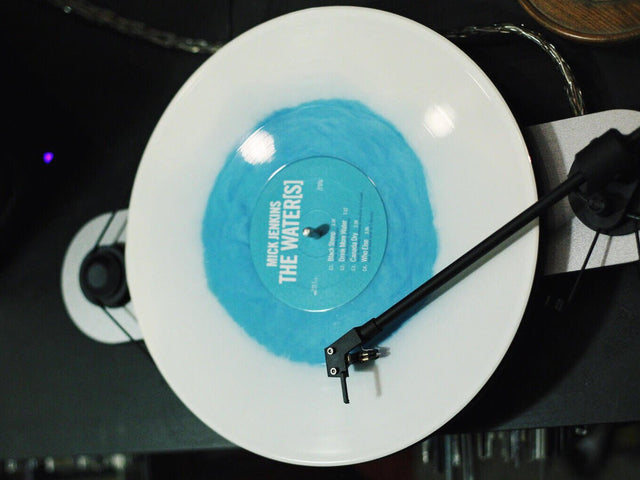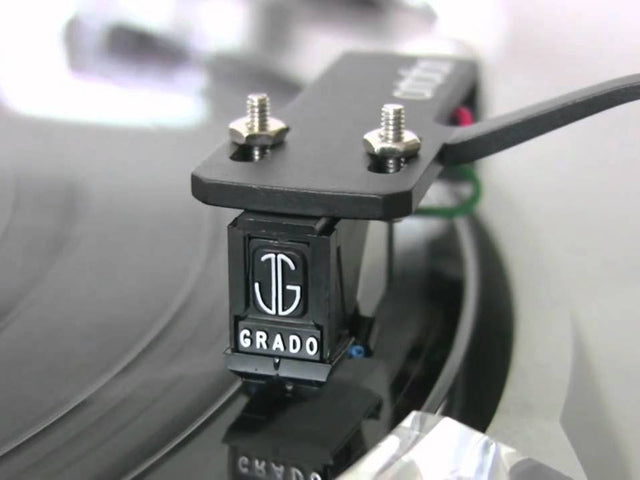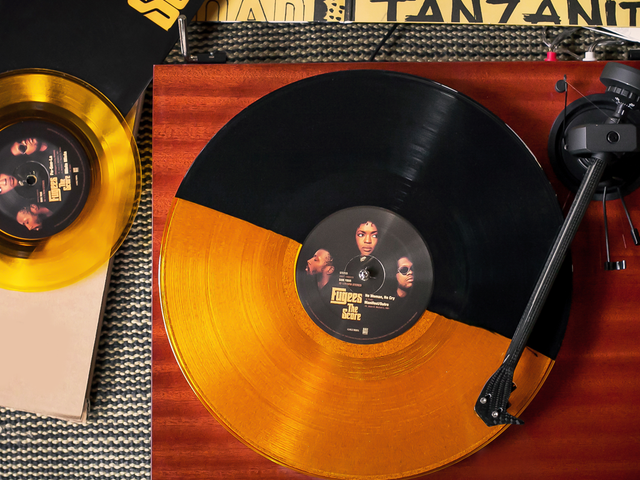The MoFi Ultradeck: We Review The New Turntable From Mobile Fidelity
Anyone who has been collecting records for any length of time knows the name Mobile Fidelity Sound Lab, or MoFi. They’ve been releasing extremely high quality reissues of classic albums since 1977. In early 2016, MoFi announced that they were were starting production of a line of turntables, cartridges and electronics, showing prototypes at numerous Hi-Fi shows. Earlier this summer, their Michigan based factory released two new turntable designs, the $1999 Ultradeck including their $499 Ultratracker cartridge, and the less expensive Studiodeck, which is priced at $1149 with their $199 StudioTracker cartridge. Here, we will focus on the Ultradeck.
When MoFi announced their new line of turntables, the minimalist industrial design immediately caught my eye. But of course performance is more important than appearance. What's really interesting is that these models were designed in collaboration with Allen Perkins. Perkins is a rock star among turntable designers, normally designing uber performance models for extremely well-heeled buyers - starting at $17,995. After parting with that pile of cash, you'll have to part with several thousand more dollars minimum for a suitable arm and cartridge. Knowing this and looking at a picture and reading the description of the prototype Ultradeck, one would expect a price in the $4,000 to $5,000 range. When prices were announced, coming in much lower than anticipated, I knew I had to try one.
Design
There's a deceiving simplicity about the Ultradeck. It looks simple, and it is simple to operate, but there's a lot of solid engineering in the Ultradeck/UltraTracker package (which comes at a discount when you buy them together). At first glance, it seems to share some design elements with the UTurn, a popular sub $500 American turntable. But digging in, one quickly sees that the Ultradeck is far more advanced.
The base features Constrained Layer Dampening: Sitting atop the MDF bottom layer are three pieces of aluminum. Each piece of aluminum isolates the three major components from each other- the motor, the platter/bearing assembly, and the arm each have their own aluminum plate. The motor is further isolated from the base as well. Both aspects of the design help block vibration reaching the platter from moving parts inside the turntable or from outside influence. The Ultradeck reacts upon four adjustable and vibration feet by HRS, a highly regarded supplier of anti vibration materials in the audio industry.
The 6.8 pound 1.3 inch tall platter is made of Delrin, with the bearing sleeve attached underneath. This allows the platter to spin freely without the use of a subplatter. Fewer parts (but parts of higher quality) often lead to increased performance. The platter is machined so that the majority of its mass is at the bottom, for increased rotational stability. The platter isn't quite 12 inches in diameter. This, combined with a recessed label area allows the playing surface to sit completely flat on the platter. No platter mat is supplied, nor should one be implemented.
The arm has an effective length of 10 inches. Most models on this price range are 9 inches. The extra inch is important. All pivoting arms have tracking error. The longer the arm, the more gentle the arc as the arm travels the playing surface. The more gentle the arc, the lower the tracking error. The arm height is easily adjustable as is the azumith, or left/right tilt of the cartridge when viewed from the front. The appropriate Allen keys are supplied. Additionally, the arm has bespoke wiring from Cardas from the cartridge clips to the output jacks. While I'm not going to tell you that Cardas cable sounds better than standard wiring, I will say that George Cardas is very well respected in the industry and his products are quite popular. One last detail that probably won't be spotted in pictures: there's an O ring between the arm tube and the headshell to assist in isolating the stylus from unwanted vibration.
Antiskate is set by the common “weight on a string” arrangement. What is different here is that the setting isn't determined by the tracking force, but by the weight of the cartridge being used. This actually makes perfect sense, as the weight of the cartridge combined with the “pull” of the groove will give it momentum as the stylus tracks the groove. The anti skate system provides resistance to this momentum so that the stylus tracks the record with equal force on both groove walls. It makes sense to me that the weight of the cartridge would have a larger effect than tracking force in regards to properly setting antiskate.
The square power button is a nod to Mofi’s heritage. It's fashioned after the buttons on the big Studer professional open reel decks in their California studio.
A note about the stylus: it isn't user replaceable. When stylus replacement time comes, the entire cartridge is exchanged for a brand new one at a reduced price. This was purposely done, as the cantilever can be installed and aligned to the magnets with much more accuracy versus a removable stylus assembly. This results in additional retrieval of low level details from the recording, improved tracking, and increased left/right stereo separation. MoFi specifies tracking force from 1.8 to 2.2 grams. I set the tracking force at 2.1 grams.
In most cases best stylus guard is one that actually gets used. Some very popular cartridges have horrible removable stylus guards that are more likely to kill styli by actually using them- stupid fiddly things. The Ultratracker’s stylus guard is removable, yet very easy to use, and it's unlikely a mishap will occur with reasonable care.
Setup
Should you decide to spring for an Ultradeck, there are some things you need to know.
Getting the Ultradeck up and running was pretty easy. Even someone inexperienced in turntable setup should have the Ultradeck spinning in under an hour, assuming they've also purchased the UltraTracker. Fit the platter and belt, then level the base- there are some great smartphone apps for this. Next, set the tracking force and antiskate. Finally make the audio connections to the amplifier and feed it AC power and it's ready to go.
There are a few things to point out, however. First, there wasn't enough grease on the platter bearing- the platter didn't spin as freely as it should have, and the bearing looked relatively dry. Although I was confident that a liberal application of lithium grease would solve the problem, I did verify my assumption with MoFi before proceeding. I used the contact form on their website and received a reply from their National Sales Manager quite quickly, actually faster than expected. Armed with a $5 tube of lithium grease, all was well, and one should have some on hand anyway, if only for annual maintenance of cleaning and relubing the platter bearing and bearing sleeve.
One tip: I usually set tracking force first, then antiskate. With the Ultradeck, I found it impossible (and frustrating) to get the antiskate weight O ring around the post on the arm. I finally removed the counterweight to gain additional access, and the O ring slipped easily onto the post.
Finally, although the Ultradeck comes with cables to connect it to the amplifier, I initially experienced some low level but easily audible hum until I substituted a pair of Blue Jeans LC-1 cables that I had on hand- $35 for a 3 foot pair. One the change was made, there was no hum whatsoever. While it's unfortunate that the factory supplied cables aren't better, this is common in the audio industry. It's not unlike the automotive industry, where performance can be increased by changing factory supplied tires for high performance aftermarket models.
In Use
The difference between my previous turntable, a heavily modified current generation Rega P3 and the Ultradeck was immediately obvious and drastic. Stark, in fact. First, albums played sounded much more like real music, a musical event, as opposed to “listening to records.” No, I'm not going to say that it sounded like the performers were in my room, that's an unrealistic goal. What it does sound like is listening to music on a great open reel tape deck, and far less like vinyl. You see, vinyl isn't the best medium for recorded music, open reel tape is. Open reel tape however is a fringe part of the audio hobby. It is inconvenient and extremely expensive if done correctly. A quality rebuilt open reel deck starts at $5,000, and a “MoFi quality” album costs around $450! Titles are limited, but growing for those who can afford it.
Me, I'm not going down that rabbit hole, but I do want the finest musical experience in my home that I can afford. The first thing that's striking about the Ultradeck is the ease that it produces music, almost like open reel tape. It's nearly impossible to describe to those who haven't experienced it, but the difference isn't subtle. The music just flows, it sounds far more real and lifelike via the Ultradeck. I'm chalking this up to excellent speed stability and the heavy Delrin platter, but it's probably the sum of all the parts that make the Ultradeck well, ultra.
The second thing that's noticeable is that the Ultradeck is the quietest turntable I've ever had. By that, I mean no hum (once the interconnects were swapped) no hiss, nothing. You'll want to use the quietest phono stage you can (and although I don't use a MoFi phono stage, I'm sure they'd appreciate it if you did.) What the silent background gives you are huge dynamic swings. Quiet recorded passages aren't mixed with noise, which in turn makes the loud parts seem louder.
I heard heaping helpings of extra detail in records that I thought I knew well, whether it be the beauty of really hearing instruments as the artist intended, or things buried way back in the mix that made themselves apparent. Along with this I heard more ambience and a better sense of the space where the recording was made with the Ultradeck, something that lesser turntables obscure or completely gloss over.
The third thing that became immediately apparent was that the 10” arm and UltraTracker are tracking champs. No matter what I played, the UltraTracker sailed through effortlessly. Inner groove distortion was non existent. I can't tell you if it's due to the arm or the cartridge, but I'd guess it's both. MoFi designed them to work together. Should you decide to buy an Ultradeck and “roll your own” regarding the cartridge, I'll stress to buy the very best you can afford. The arm (and your ears and records) deserve it. But I've not heard anything near $200 (the cost of the UltraTracker when purchased with the turntable) that comes close. Spring for the UltraTracker. You won't regret it.
Speaking of the UltraTracker, it's one of the best (if not the best) cartridges I've ever heard as far as suppressing surface noise. While it won't (and can't) turn a beat up garage sale find into a near mint copy, it's brilliant when it comes to playing well cared for but well loved LPs. I've got quite a few in my collection, and all of them sounded nearly new, as did some new pressings that were a bit noisy when played on the Rega.
Tonally, the Ultradeck is about as neutral as I've ever heard. If you are accustomed to (or like) a big fat warm sound, the Ultradeck isn't it. Sure, it sounds big, really big in fact, but it isn't going to add anything to the sound of your records. You'll get pounding bass if it's on the record to begin with, but the Ultradeck doesn't “warm” or “sweeten” anything. Through the midrange, it's clean and clear, and the highs are crisp and sparkling. The great sounding records in your collection are likely to become stunningly fantastic. Poorly recorded records are what they are. They may not sound “better” or “worse” but they will certainly sound different.
Summing Up
Taking into account the high level of performance and engineering MoFi has achieved with the Ultradeck, I suspect they've got a hit on their hands. Compared to it's likely competition, the Technics SL-1200G, Rega P6 as well as various models from Pro-Ject and Music Hall, the Ultradeck is as different as those models are from each other. Whether or not the Ultradeck is right for you will come down to what you value in a turntable. Although I'm within my 60 day home audition period, I can assure you that the Ultradeck is here to stay. At this level, one will have to spend far more for an uncertain performance outcome. Different? Yes. Better? I'm not so sure.
With the Ultradeck, MoFi has produced an American made turntable that's well engineered and built, looks great, and sounds sublime- and they brought it to market at a very reasonable price. I can see why it took so long to finally become available. The wait was well worth it.
Nels Ferre spent 10 years in audio retail and has previously written audio reviews for numerous online publications. He has an obsession with all things Beatles and Jethro Tull.



